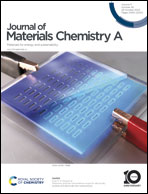Phase-engineered two-dimensional MoO3/MoS2 hybrid nanostructures enable efficient indoor organic photovoltaics†
Abstract
Organic photovoltaics (OPVs) have become a niche application for driving off-grid Internet-of-things (IoT) devices in indoor settings. Two-dimensional nanostructured transition metal sulfides (TMSs) play a pivotal role in this context owing to their unique photophysical, optoelectronic, and structural characteristics. Non-fullerene acceptor (NFA)-based OPVs doped with core–shell structured hybrid TMSs are fabricated, demonstrating a marked power conversion efficiency (PCE) of 27.9% under 1000 lx light-emitting diode (LED) illumination. The TMS hybrid nanostructures enable compact molecular packing and effectively enhance the absorption strength of the active layers, in addition to optimizing their nanomorphology, yielding significant improvements in the current density and fill factor of indoor OPVs. In addition, an optimal amount of TMSs in the active layers reduces trap-assisted recombination and boosts the charge dissociation efficiencies and carrier mobilities, leading to enhanced PCEs. This study represents a significant advance in harnessing the potential of 2D TMSs in state-of-the-art OPVs under dim indoor lighting conditions.



 Please wait while we load your content...
Please wait while we load your content...